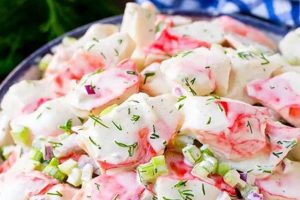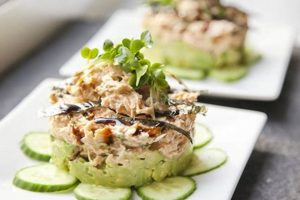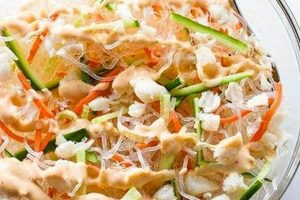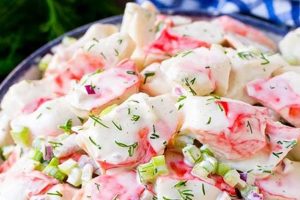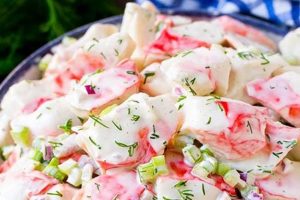A dish featuring crab meat combined with other seafood, often including shrimp, lobster, or white fish, bound together with a mayonnaise-based dressing and enhanced with various seasonings and vegetables. Classic examples may incorporate celery, onion, and fresh herbs such as dill or parsley. Variations can include the addition of fruits like mango or avocado, creating a fusion of flavors and textures.
Chilled seafood salads offer a refreshing and flavorful meal, particularly suitable for warm weather. They provide a good source of protein and omega-3 fatty acids, depending on the seafood included. Historically, combining seafood with dressings and accompaniments has been a culinary practice across numerous cultures, reflecting resourcefulness and creativity in utilizing readily available ingredients. Modern interpretations emphasize both taste and presentation, often incorporating diverse culinary influences.
This exploration will delve into various aspects of preparing a delectable seafood and crab combination, including selecting fresh ingredients, crafting a balanced dressing, and considering appropriate accompaniments. Furthermore, variations on the classic preparation will be explored, highlighting both traditional and contemporary approaches to this versatile dish.
Tips for an Exceptional Seafood Crab Salad
Creating a superior seafood crab salad involves careful attention to detail, from ingredient selection to final presentation. The following tips offer guidance for achieving optimal results.
Tip 1: Prioritize Fresh, High-Quality Ingredients: Success hinges on using the freshest seafood available. Opt for high-quality crab meat, preferably from a reputable fishmonger. Likewise, any additional seafood incorporated should exhibit optimal freshness.
Tip 2: Balance Flavors within the Dressing: The dressing should complement, not overpower, the delicate flavor of the seafood. A classic mayonnaise base can be enhanced with lemon juice, Dijon mustard, and a touch of horseradish for a balanced profile.
Tip 3: Consider Texture: A pleasing textural contrast enhances the overall experience. Finely diced celery and onion offer a satisfying crunch, while the inclusion of avocado introduces a creamy element.
Tip 4: Season Judiciously: Seasoning should enhance the natural flavors of the ingredients. Fresh herbs like dill and parsley provide brightness, while a pinch of cayenne pepper can add a subtle touch of heat.
Tip 5: Chill Thoroughly Before Serving: Chilling allows the flavors to meld and creates a refreshing dining experience, particularly beneficial in warmer weather.
Tip 6: Exercise Restraint with Fillers: Avoid excessive use of fillers like shredded lettuce or chopped tomatoes, which can dilute the flavor and create a watery consistency.
Tip 7: Presentation Matters: Thoughtful plating enhances the appeal. Serve the salad on crisp lettuce cups, crackers, or toasted baguette slices for an elegant presentation.
By adhering to these guidelines, one can elevate a simple seafood crab salad into a culinary masterpiece, showcasing the inherent quality of the ingredients and offering a delightful sensory experience.
These tips provide a foundation for crafting an exceptional seafood crab salad. The following section will explore variations and serving suggestions to further inspire culinary creativity.
1. Fresh, High-Quality Ingredients
The success of any seafood crab salad hinges directly on the quality of its core components. Fresh, high-quality seafood contributes not only to superior flavor but also to food safety. Delicate ingredients like crab and other seafood are susceptible to rapid deterioration, impacting both taste and potential health risks. Using inferior ingredients can result in a bland, fishy, or even unsafe final product. Conversely, fresh, properly handled seafood provides a clean, sweet flavor that allows the nuances of the other ingredients to shine. For example, freshly cooked and chilled crab meat offers a distinctly sweet and briny flavor compared to pre-packaged, pasteurized options, which can sometimes have a metallic or overly salty taste. The difference is readily apparent in the final dish.
Sourcing seafood from reputable suppliers who prioritize sustainable practices and proper handling ensures optimal quality. Look for vibrant color, a pleasant aroma, and firm texture in both crab and any accompanying seafood. Beyond the seafood itself, the remaining ingredients also benefit from freshness. Crisp, recently harvested vegetables contribute vibrant flavor and satisfying texture. Using freshly squeezed lemon juice rather than bottled varieties provides a brighter, more nuanced acidity. These seemingly small choices cumulatively elevate the final product from satisfactory to exceptional.
Prioritizing ingredient quality represents a fundamental step towards crafting a truly exceptional seafood crab salad. The enhanced flavor, improved texture, and ensured food safety justify the extra effort in sourcing the best possible components. This dedication to quality underscores a commitment to culinary excellence and a respect for the delicate nature of seafood.
2. Balanced, Complementary Dressing
A balanced, complementary dressing is paramount in a seafood crab salad recipe. The dressing serves as the unifying element, binding the ingredients while enhancing, not overpowering, the delicate flavors of the seafood. An overly assertive dressing can mask the subtle sweetness of the crab and other seafood, resulting in a muddled, less satisfying experience. Conversely, a well-crafted dressing complements the inherent flavors, creating a harmonious blend where each component contributes to the overall profile. A classic example is a light lemon-dill mayonnaise. The brightness of the lemon cuts through the richness of the mayonnaise, while the dill provides a fresh, herbaceous note that complements the crab. This combination allows the natural sweetness and briny character of the seafood to shine.
Achieving this balance requires careful consideration of acidity, richness, and aromatics. Acidity, often from lemon juice or vinegar, provides a necessary counterpoint to the richness of the mayonnaise or other base. Aromatic elements, such as fresh herbs or spices, contribute complexity and depth. The interplay of these components creates a dynamic flavor profile that elevates the salad beyond a simple sum of its parts. Consider a variation incorporating a touch of Dijon mustard. The subtle tang of the mustard adds another layer of flavor, further enhancing the overall experience without overwhelming the delicate crab. The quantity of each ingredient must be carefully calibrated to ensure a harmonious blend.
Mastering the art of crafting a balanced, complementary dressing is essential for achieving a truly exceptional seafood crab salad. This understanding allows one to showcase the quality of the ingredients while creating a dish that is both flavorful and refreshing. The delicate balance between acidity, richness, and aromatics within the dressing transforms individual components into a cohesive, harmonious whole. This culinary synergy ultimately elevates the dish from simple to sublime.
3. Textural Variety
Textural variety plays a crucial role in elevating a seafood crab salad recipe from simple to exceptional. A combination of textures creates a more engaging and satisfying culinary experience, transforming a potentially one-dimensional dish into a dynamic interplay of sensations. The interplay of contrasting textures adds depth and complexity, appealing to a broader range of palates and enhancing overall enjoyment.
- Crunchy Elements:
Crunchy components provide a counterpoint to the softer textures of seafood and dressing. Finely diced celery, water chestnuts, or chopped bell peppers introduce a refreshing crispness. These elements contribute a satisfying bite, preventing the salad from becoming overly soft or homogenous. For example, the snap of celery against the tender flakes of crab meat creates a delightful contrast.
- Creamy Components:
Creamy textures add richness and bind the salad together. Avocado, a classic addition, provides a smooth, buttery mouthfeel that complements the delicate seafood. A touch of crme frache or softened cream cheese can also contribute to this luxurious element, enhancing the overall sensory experience. The creaminess of avocado, for instance, contrasts beautifully with the crunch of celery and the tender crab.
- Flaky Seafood:
The inherent flakiness of the crab meat itself contributes significantly to the textural profile. High-quality crab meat should exhibit delicate, distinct flakes, offering a tender yet substantial bite. Supplementing the crab with other seafood, such as flaked cooked fish or small shrimp, further enhances this textural dimension. The interplay of these varying seafood textures adds complexity and interest.
- Dressing Consistency:
The consistency of the dressing also plays a role in the overall textural experience. A thick, creamy dressing clings to the other ingredients, creating a cohesive blend. A lighter, vinaigrette-style dressing offers a contrasting lightness and allows the individual textures of the other components to stand out more prominently. The choice of dressing consistency depends on the desired final texture of the salad.
The strategic incorporation of these various textural elements elevates the seafood crab salad from a simple mixture of ingredients to a multi-faceted culinary creation. A well-balanced combination of crunchy, creamy, flaky, and appropriately dressed components delivers a more engaging and satisfying dining experience. The interplay of these textures enhances not only the enjoyment of the dish but also its perceived complexity and overall quality.
4. Appropriate Seasoning
Appropriate seasoning is fundamental to a successful seafood crab salad recipe. Seasoning enhances the inherent flavors of the seafood and other ingredients without masking their delicate nature. It provides depth and complexity, transforming a simple mixture into a nuanced culinary creation. The delicate nature of crab and other seafood requires a judicious approach. Over-seasoning can easily overwhelm these subtle flavors, resulting in a dish that tastes more of the seasoning than the core ingredients. Conversely, insufficient seasoning can lead to a bland, uninspired result. The goal is to achieve a harmonious balance where the seasoning complements and elevates the natural flavors of the seafood and other components.
Consider the classic pairing of crab with Old Bay seasoning. The blend of spices in Old Bay, including celery salt, paprika, and mustard, complements the sweetness of the crab without overpowering it. A light touch is key; too much Old Bay can easily dominate the flavor profile. Alternatively, fresh herbs like dill and parsley provide a brighter, more herbaceous note. These herbs offer a fresh counterpoint to the richness of the crab and dressing, creating a balanced flavor profile. A touch of lemon zest can further enhance the brightness and complexity of the dish. In contrast, heavier spices like cumin or chili powder might overpower the delicate flavors of the crab and other seafood, making them less suitable for this particular application.
Achieving appropriate seasoning requires careful consideration of the delicate balance between enhancing and overpowering the inherent flavors of the seafood. It involves understanding the interplay of different spices and herbs and how they interact with the other ingredients. This knowledge allows one to create a seafood crab salad that is not only flavorful but also showcases the quality and freshness of its core components. The judicious use of seasoning ultimately elevates the dish from simple to sophisticated, transforming a basic combination of ingredients into a nuanced and satisfying culinary experience.
5. Proper Chilling and Presentation
Proper chilling and presentation are crucial final steps in a seafood crab salad recipe, significantly impacting both food safety and sensory appeal. Chilling ensures the salad remains safe for consumption and allows the flavors to meld, while thoughtful presentation elevates the dining experience. Neglecting these aspects can compromise the quality and enjoyment of the dish, diminishing the impact of even the finest ingredients and most carefully crafted dressings.
- Food Safety Through Chilling:
Chilling is paramount for food safety, particularly with perishable ingredients like seafood. Maintaining a temperature below 40F (4C) inhibits bacterial growth, minimizing the risk of foodborne illness. Prompt and thorough chilling after preparation is crucial. Any delay in refrigeration can allow harmful bacteria to proliferate, posing a health hazard. This is particularly important for seafood crab salad, often served cold, as improper temperature control can create an environment conducive to bacterial growth.
- Flavor Development During Chilling:
Beyond safety, chilling allows the flavors of the various components to meld and harmonize. The flavors of the seafood, dressing, and other ingredients intermingle during refrigeration, creating a more cohesive and complex flavor profile. This process of flavor development is particularly noticeable in dishes with diverse ingredients, like seafood crab salad, where the chilling period allows the individual flavors to integrate into a unified whole.
- Enhanced Sensory Appeal Through Presentation:
Presentation enhances the sensory experience, impacting both visual appeal and perceived flavor. A thoughtfully plated seafood crab salad is more enticing and enjoyable to consume. Simple yet elegant serving suggestions include using crisp lettuce cups, crackers, or toasted baguette slices. Garnishing with fresh herbs or a sprinkle of paprika adds visual interest and reinforces the flavor profile. Attractive presentation stimulates the appetite and elevates the perceived value of the dish.
- Practical Considerations for Serving:
Practical considerations, such as appropriate serving vessels and utensils, contribute to the overall dining experience. Serving the salad in chilled bowls or on a bed of ice maintains the desired temperature. Providing appropriate serving utensils, such as small forks or spoons, ensures easy consumption. Attention to these details demonstrates care and consideration for the diner, enhancing enjoyment and preventing potential awkwardness or spills.
Proper chilling and presentation are integral elements of a successful seafood crab salad recipe, representing the culmination of careful preparation and attention to detail. These final steps ensure both the safety and sensory appeal of the dish, transforming a collection of ingredients into a cohesive and enjoyable culinary experience. By prioritizing these elements, one elevates the seafood crab salad from a simple dish to a culinary creation that delights both the palate and the eye.
Frequently Asked Questions
This section addresses common inquiries regarding seafood crab salad preparation, offering concise and informative responses.
Question 1: What types of crab meat are best suited for seafood crab salad?
Jumbo lump or backfin crab meat is generally preferred for its delicate flavor and texture. Claw meat, while less expensive, can be incorporated for a more robust flavor and textural variation.
Question 2: Can other types of seafood be added?
Shrimp, lobster, and flaked white fish such as cod or haddock complement crab well. Ensure any added seafood is cooked thoroughly and chilled before incorporating.
Question 3: How long can seafood crab salad be stored safely?
Refrigerate promptly after preparation and consume within two days for optimal quality and safety. Ensure the salad is stored in an airtight container at or below 40F (4C).
Question 4: What are suitable accompaniments for serving?
Lettuce cups, crackers, toasted baguette slices, or avocado halves provide appealing vessels for serving. Consider garnishing with fresh herbs or a sprinkle of paprika.
Question 5: Can frozen crab meat be used?
While fresh crab meat is ideal, frozen crab meat can be substituted if thawed completely and drained thoroughly before use. Be mindful that the texture might differ slightly.
Question 6: How can one avoid a watery salad?
Ensure all ingredients, particularly vegetables, are dry before incorporating. Avoid overmixing, which can release excess moisture from the ingredients. Using a thicker dressing can also help bind the salad and prevent excess liquid.
Careful attention to ingredient selection, preparation methods, and storage guidelines ensures both a safe and delectable seafood crab salad experience. Understanding these key aspects empowers culinary exploration and facilitates informed decision-making.
The following section will provide a sample recipe to guide preparation.
Seafood Crab Salad Recipe
Exploration of this multifaceted dish reveals the importance of quality ingredients, balanced flavors, textural variety, appropriate seasoning, and proper chilling and presentation. Fresh seafood, a complementary dressing, and the interplay of textures create a harmonious and satisfying culinary experience. Careful attention to these details elevates a simple combination of ingredients into a refined dish.
Successful execution of a seafood crab salad recipe relies on a nuanced understanding of these interconnected elements. This knowledge empowers culinary creativity, enabling adaptation and refinement to suit individual preferences and available resources. The enduring appeal of this versatile dish lies in its adaptability and the potential for continuous refinement, ensuring its continued presence in culinary traditions worldwide.

